If you’re planning a trip to Petrified Forest National Park, this guide will help you get there, pick the best season, and see the highlights while protecting the park’s fragile resources. You’ll find practical tips on routes, timing, must-see stops like the Painted Desert and Crystal Forest, and sensible safety and Leave No Trace advice to make your visit rewarding and low-impact. Keep going to map out the visit that fits your pace and interests.
What Is Petrified Forest National Park and Why Visit
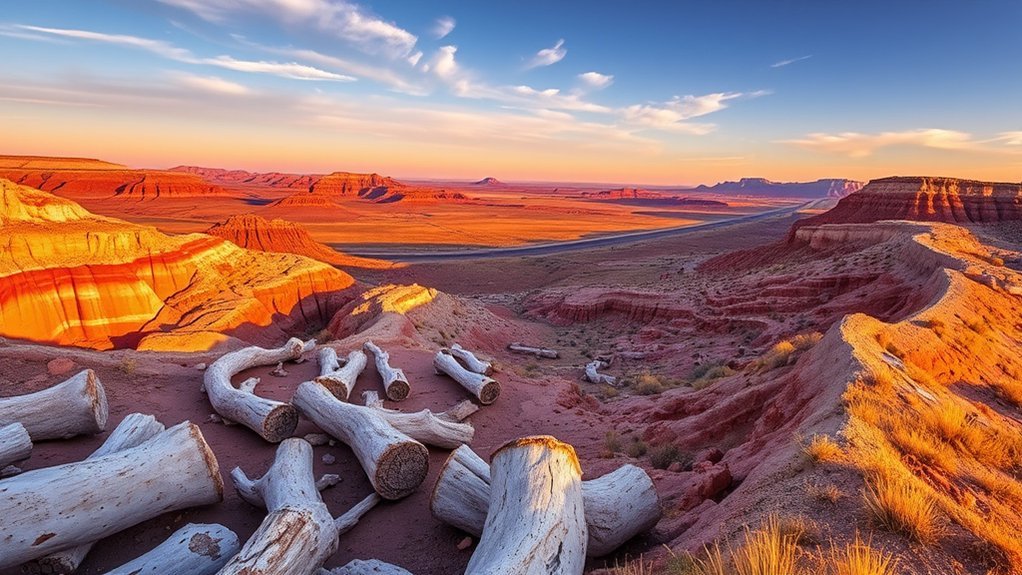
Petrified Forest National Park sits in northeastern Arizona and protects one of the world’s largest and most accessible deposits of petrified wood—logs turned to colorful stone over 225 million years ago—set within 346 square miles of Painted Desert badlands and Triassic rock layers. You’ll find why it’s worth visiting when you explore colorful formations, trails and viewpoints that reveal ancient trees fossilized into agate and jasper. The Rainbow Forest Museum anchors the park’s interpretive efforts, helping you understand geology, paleontology and stewardship. As a conservation-minded traveler, you’ll appreciate that the park balances access with protection of fragile resources. Plan visits in spring or fall—the best times to visit—to enjoy milder weather at one of the Southwest’s beautiful places.
How to Get to Petrified Forest National Park

Want to know the easiest way in? You’ll access Petrified Forest National Park via Interstate 40; use the southern entrance at exit 285 if you’re heading east or the northern entrance at exit 311 if you’re heading west. The closest major airports are Phoenix Sky Harbor, Albuquerque Sunport, and Flagstaff Pulliam, but you’ll need a rental car—there’s no shuttle—when accessing the park. Drive Petrified Forest Road, a 28-mile corridor linking trails and viewpoints; it’s the backbone of park exploration. Pay a $25 entrance fee per private vehicle for seven-day access, or enter free with an America the Beautiful Pass. Plan drives and parking thoughtfully to minimize impacts on fragile petrified wood and surrounding desert ecosystems.
Best Time of Year to Visit and Weather Tips
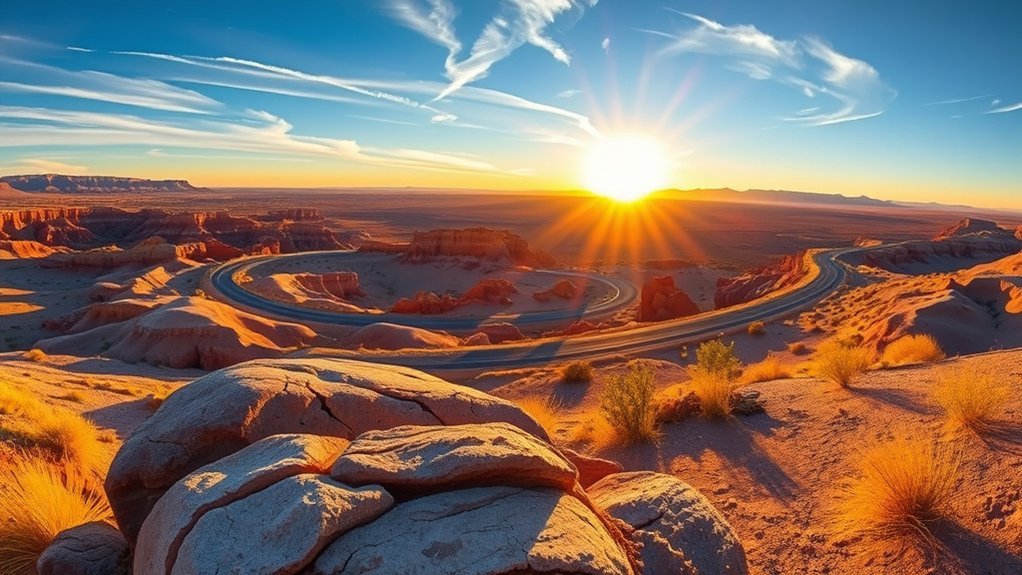
Because spring and fall bring milder temperatures and blooming wildflowers, those seasons are the best times to visit the park for comfortable hiking and vibrant vistas. You’ll find mild temperatures, peak wildflowers from April to June, and lower crowds. Avoid summer heat—temperatures often exceed 100°F—unless you plan early starts, lots of water and strong sun protection. Winter gives quiet, sometimes snowy scenes but expect chilly conditions and gusty winds. The monsoon season (July–September) can deepen Painted Desert colors but brings sudden storms; monitor forecasts and avoid washes. Respect fragile habitats: stay on trails and pack out trash. Use this quick reference for planning.
| Season | Conditions | Tip |
|---|---|---|
| Spring | Mild, blooms | Start hikes early |
| Summer | Extreme heat | Hydrate, avoid midday |
| Winter/Monsoon | Cold, storms | Check forecasts |
Top Sights and Must-See Stops Along Petrified Forest Road
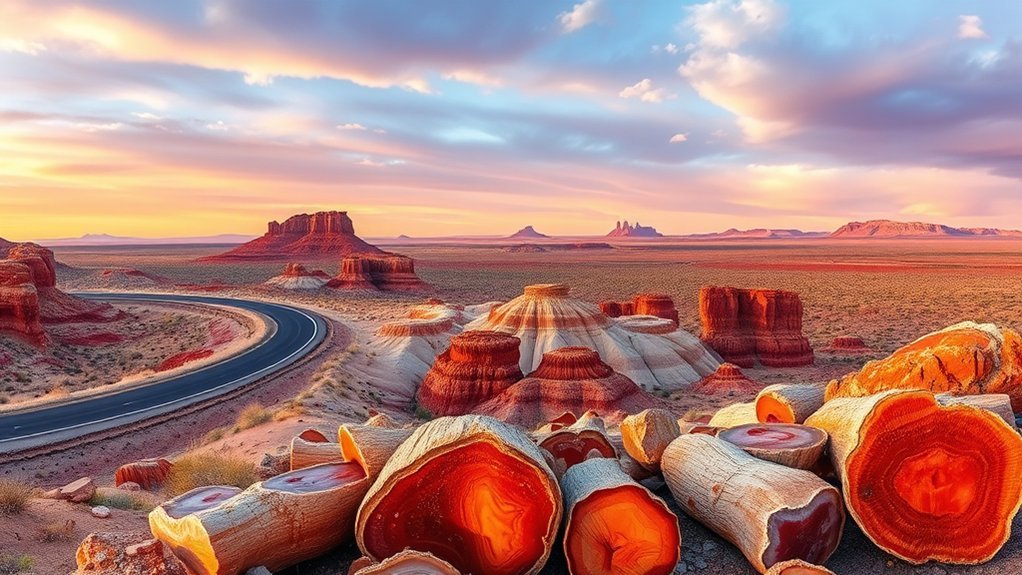
As you drive Petrified Forest Road, stop at the Painted Desert viewpoints for sweeping, protected views of the colorful badlands and remember to stay on designated paths to preserve fragile soils. Hike the Crystal Forest Trail, a short loop where you’ll see vibrantly hued petrified logs up close while following Leave No Trace principles. Don’t miss the Historic Agate House—an expertly restored Puebloan structure built with polished agate and petrified wood that illustrates the park’s cultural history.
Painted Desert Viewpoints
The Painted Desert’s rim unfolds in a series of easily accessible viewpoints along Petrified Forest Road, where short stops like Tiponi Point, Tawa Point, and Kachina Point deliver sweeping vistas of the colorful badlands and layered mesas. You’ll use the Painted Desert Rim Trail for an easy 1-mile walk or drive to pullouts for quicker scenic views. Stop at Newspaper Rock overlook to study petroglyphs and respect their cultural significance. Photograph the Tepees’ zebra-striped colorful formations but avoid disturbing fragile soils. Plan a visit to the Painted Desert Inn to learn Route 66 history and park stewardship. Stay on trails, pack out trash, and leave artifacts for future visitors.
| Viewpoint | Highlight |
|---|---|
| Tiponi Point | Panoramas |
| Tawa Point | Sunrise views |
| Kachina Point | Layered mesas |
| Tepees | Colorful formations |
| Inn Overlook | History & museum |
Crystal Forest Trail
A short, paved loop just off Petrified Forest Road, the Crystal Forest Trail lets you get close to hundreds of colorful petrified logs and their quartz-rich interiors; you’ll see trees of many sizes and read interpretive signs that explain how wood turned to stone over 200 million years. On this 0.75-mile loop in Petrified Forest National Park, you’ll have an immersive experience observing vibrant crystals and learning the geological history that produced them. The trail is accessible and suitable for visitors of all ages, so you can study the textures of petrified logs and imagine ancient trees falling into rivers and being buried by sediment. Follow the interpretive signs, stay on the path, and resist collecting specimens to protect this irreplaceable resource.
Historic Agate House
Just a short hike past the Crystal Forest, you’ll find the Historic Agate House, a reconstructed pueblo built largely from colorful petrified wood that tells the story of ancestral Puebloan life here roughly 700 years ago. When you follow the Long Logs and Agate House Trail, the 2-mile round trip hike rewards you with impressive petrified logs and an intimate look at traditional masonry using fossilized wood. The historic Agate House interprets how people adapted to this arid landscape; exhibits and signage emphasize preservation and respect. As you explore the surrounding landscape, note the vibrant colors and geological formations that define the Painted Desert. Located along Petrified Forest Road, this site is a must-see—leave artifacts and stay on trails to protect it.
Best Hikes and Scenic Walks to Experience
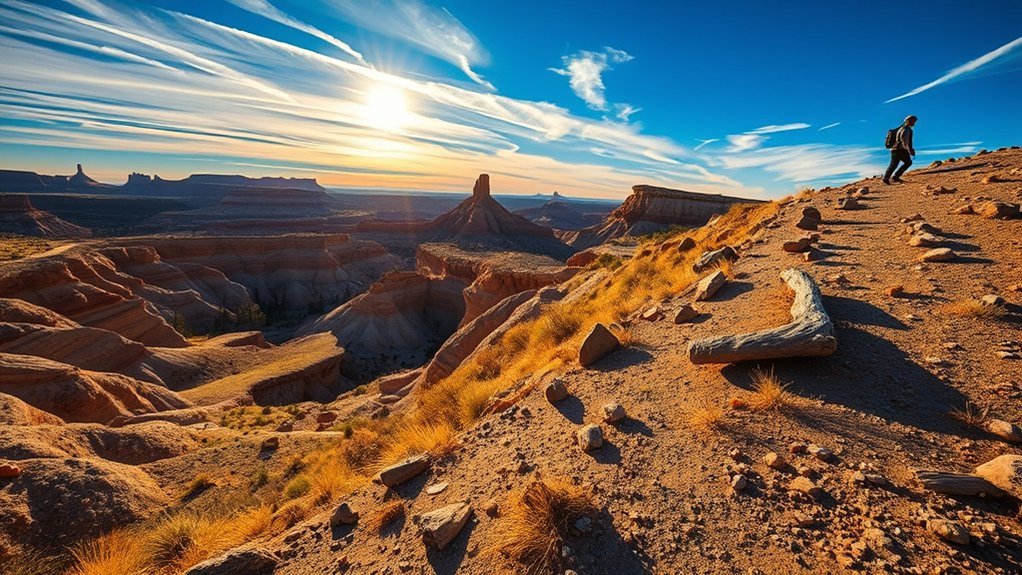
Because you’ll want to see petrified wood up close, plan a mix of short, paved loops and longer, rougher trails to get the full range of the park’s landscapes and history. Start with the Giant Logs Trail for a quick, 0.34-mile look at some of the largest, most colorful pieces. Walk the Crystal Forest Trail’s 0.75-mile paved path to study thousands of crystalized logs without straying from the trail. For broader context, do the Long Logs and Agate House Loop Trail—2.6 miles that combine natural and cultural history at a reconstructed pueblo. Hike the Blue Mesa Trail to enjoy badland views and smaller fragments. Adventurous hikers should try the less-developed Jasper Forest Trail to find dense concentrations of petrified wood while practicing Leave No Trace and respect for natural history.
Practical Planning: Hours, Fees, Rules, and Accessibility
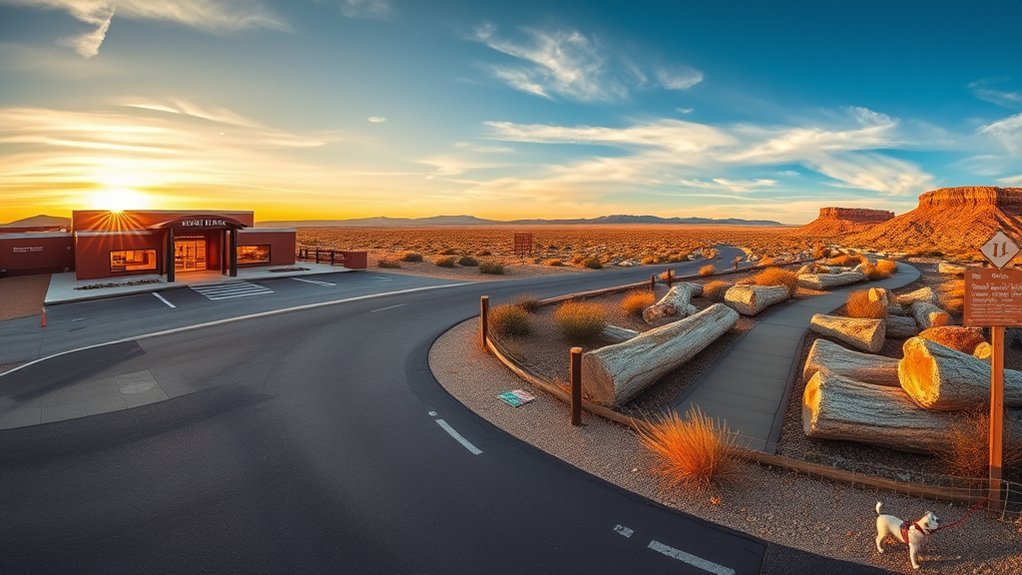
Plan your visit around the park’s hours—it’s open year‑round from 8 a.m. to 5 p.m. MST, and you can stay until sunset if you enter by 5. Expect standard entrance fees (or bring an America the Beautiful Pass), follow leash and Leave No Trace rules, and note that paved roads and two entrances make most sites accessible though some parking and trail sections have limits for RVs or bikes.
Hours and Fees
A visit to Petrified Forest National Park requires a bit of practical planning: the park is open year‑round (closed only on December 25), with standard hours from 8 a.m. to 5 p.m. Mountain Standard Time; if you enter by 5 p.m. you can stay until sunset. The entrance fee for a private vehicle is $25 and covers seven days; an America the Beautiful Pass provides broader access to over 2,000 sites for $80. Note operating hours may vary seasonally or for events, so check before you go. Respect Leave No Trace principles: removing petrified wood is illegal and fines start at $325. The park offers accessible facilities and paved trails for many visitors, though some routes require extra skill or preparation.
Rules and Accessibility
When you visit Petrified Forest National Park, follow the rules and accessibility guidelines to protect its resources and guarantee a safe, welcoming experience for everyone. The park is open year‑round (closed Dec 25) with standard hours 8 a.m.–5 p.m.; you can stay until sunset if you enter by 5. Entrance fees apply, but America the Beautiful Pass holders get free entry. Visitor centers explain Leave No Trace principles and the prohibition on removing park resources; violations can bring fines.
- Use developed trails and viewpoints off the 28‑mile road for safer hiking and better access.
- Dogs permitted but must be leashed, cleaned up after, and can join the Bark Ranger program.
- Check accessibility info at visitor centers for routes and services.
Nearby Towns, Lodging, and Day-Trip Extensions
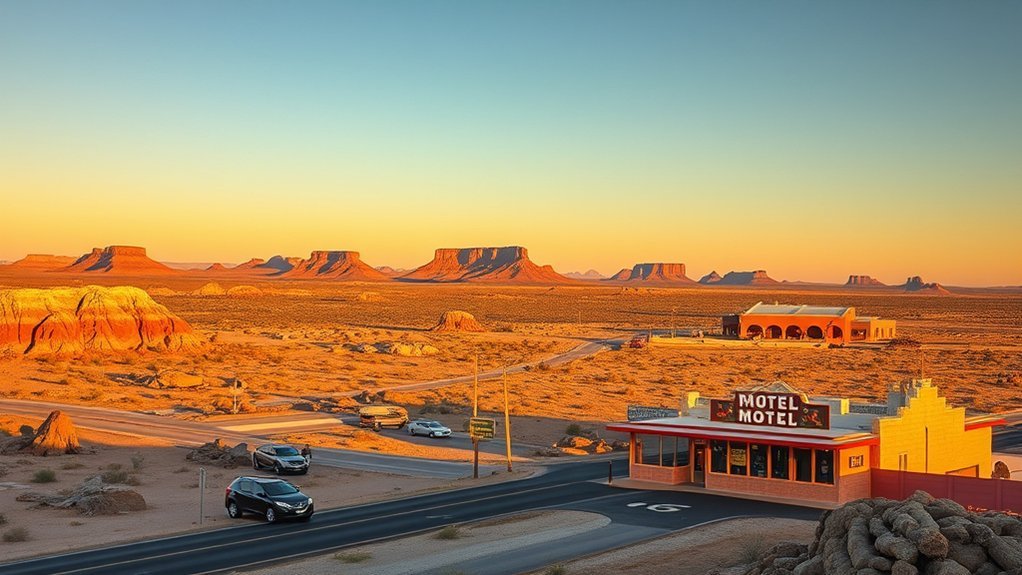
Though the park itself feels remote, nearby Holbrook—about 26 miles west—gives you convenient lodging, dining, and services that support responsible visits to Petrified Forest National Park. You’ll find Route 66 charm in family-run motels like the 66 Motel, updated options such as Brad’s Desert Inn, and chain comfort at La Quinta Inn and Suites for comfortable stays. Eat locally at the Painted Desert Diner for Navajo tacos or try Swaad Stop for different flavors. For day-trip extensions, plan stops at Two Guns, Meteor Crater, and rock shops along Route 66 where you can buy unique souvenirs. Fall visiting offers milder weather and fewer crowds, ideal for exploring without stressing fragile resources.
Frequently Asked Questions
How Much Time Do You Need at Petrified Forest National Park?
You’ll need about 3–5 hours to enjoy park trails, scenic viewpoints, visitor center exhibits, photography spots, picnic areas, guided tours, wildlife watching, and geological features while following park regulations and choosing responsible park activities.
How Much Time Do You Need for a Petrified Forest?
You’ll need about 3–5 hours to see petrified wood and fossilized trees; follow hiking trails, visit scenic viewpoints and the visitor center, enjoy park activities, wildlife spotting, photography tips, geology facts, and obey park regulations.
Can You Just Drive Through Petrified Forest National Park?
Yes — you can drive through the park via scenic drives; use main park entrances and visitor centers for maps. Follow road conditions, driving routes, safety tips, enjoy wildlife viewing, photography spots, picnic areas, and guided tours.
When to Visit Petrified Forest National Park?
A photographer friend visited in April and captured blooms; you should plan spring or fall for best seasons, mild weather conditions, peak visitation balance; consider park events, photography tips, wildlife watching, trail recommendations, camping options, guided tours, park accessibility.
Conclusion
Petrified Forest National Park offers a rare window into deep time and fragile landscapes—so why treat it like just another stop? Plan your route via I‑40 (exits 285 or 311), visit in spring or fall, pack plenty of water, and stay on trails to protect the park’s petrified wood and painted vistas. Prioritize Crystal Forest, Painted Desert viewpoints, and Agate House, follow park rules, and leave no trace so future visitors can enjoy this place too.

